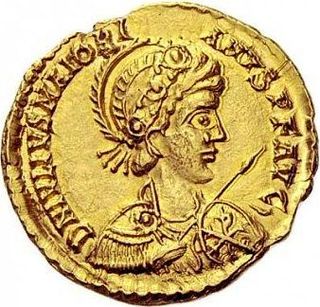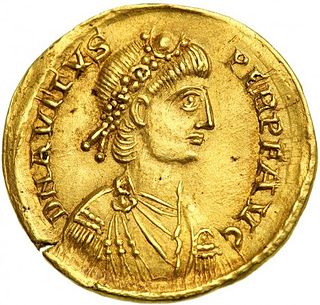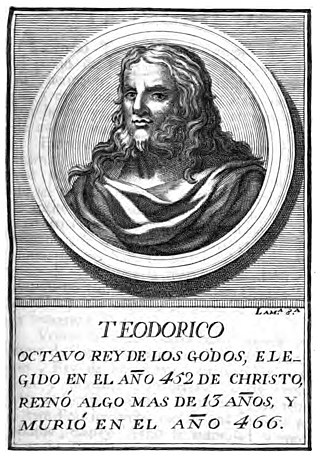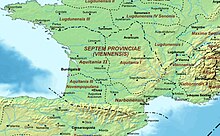
The Burgundians were an early Germanic tribe or group of tribes. They appeared in the middle Rhine region, near the Roman Empire, and were later moved into the empire, in eastern Gaul. They were possibly mentioned much earlier in the time of the Roman Empire as living in part of the region of Germania that is now part of Poland.
The 450s decade ran from January 1, 450, to December 31, 459.
The 460s decade ran from January 1, 460, to December 31, 469.

Ricimer was a Romanized Germanic general who effectively ruled the remaining territory of the Western Roman Empire from 456 after defeating Avitus, until his death in 472, with a brief interlude in which he contested power with Anthemius. Deriving his power from his position as magister militum of the Western Empire, Ricimer exercised political control through a series of puppet emperors. Ricimer's death led to unrest across Italy and the establishment of a Germanic kingdom on the Italian Peninsula.

Majorian was the Western Roman emperor from 457 to 461. A prominent commander in the Western military, Majorian deposed Avitus in 457 with the aid of his ally Ricimer. Possessing little more than Italy, Dalmatia, as well as some territory in Hispania and northern Gaul, Majorian campaigned rigorously for three years against the Empire's enemies. In 461, he was murdered at Dertona in a conspiracy, and his successors until the Fall of the Empire in 476 were puppets either of barbarian generals or the Eastern Roman court.

Procopius Anthemius was the Western Roman emperor from 467 to 472. Born in the Eastern Roman Empire, Anthemius quickly worked his way up the ranks. He married into the Theodosian dynasty through Marcia Euphemia, daughter of Eastern emperor Marcian. He soon received a significant number of promotions to various posts, and was presumed to be Marcian's planned successor. However, Marcian's sudden death in 457, together with that of Western emperor Avitus, left the imperial succession in the hands of Aspar, who instead appointed Leo, a low-ranking officer, to the Eastern throne, probably out of fear that Anthemius would be too independent. Eventually, this same Leo designated Anthemius as Western emperor in 467, following a two-year interregnum that started in November 465.

Eparchius Avitus was Roman emperor of the Western Empire from July 455 to October 456. He was a senator of Gallic extraction and a high-ranking officer both in the civil and military administration, as well as Bishop of Piacenza.
Aegidius was the ruler of the short-lived Kingdom of Soissons from 461 to 464/465. Before his ascension he was an ardent supporter of the Western Roman emperor Majorian, who appointed him magister militum per Gallias in 458. After the general Ricimer assassinated Majorian and replaced him with Emperor Libius Severus, Aegidius rebelled and began governing his Gallic territory as an independent kingdom. He may have pledged his allegiance to the Eastern Roman emperor Leo I.

Theodoric II, Teodorico in Spanish and Portuguese, was the eighth King of the Visigoths, from 453 to 466.

The Kingdom or Domain of Soissons is the historiographical name for the ethnically Roman, de facto independent remnant of the Western Roman Empire's Diocese of Gaul, which existed during Late Antiquity as an initially nominal enclave and later rump state of the Empire until its conquest by the Franks in AD 486. Its capital was at Noviodunum, today the town of Soissons in France.

Marcellinus was a Roman general and patrician who ruled over the region of Dalmatia in the Western Roman Empire and held sway with the army there from 454 until his death. Governing Dalmatia both independently from, and under, six Emperors during the twilight of the Western Empire, Marcellinus proved to be an able administrator and military personality with sources making reference that he ruled justly and well and kept Dalmatia independent of the emperor and of barbarian rulers.

Libius Severus, sometimes enumerated as Severus III, was Western Roman emperor from 461 to his death in 465. A native of Lucania, Severus was the fourth of the so-called "Shadow Emperors" who followed the deposition of the Valentinianic dynasty in 455. He ruled for just under four years, attaining the throne after his predecessor, Majorian, was overthrown by his magister militum, Ricimer. Severus was the first of a series of emperors who were highly dependent on the general, and it is often presumed that Ricimer held most of the de facto power during Severus' reign
Agrippinus was a general of the Western Roman Empire, Magister militum per Gallias under emperors Valentinian III, Petronius Maximus, Avitus and Libius Severus.
Nepotianus was a general of the Western Roman Empire.
The Battle of Arelate was fought in 458 near Arelate (Arles) between Western Roman Emperor Majorian and Visigothic king Theodoric II. After the assassination of Flavius Aetius in 454, the Visigoths began to expand their kingdom at the expense of the crumbling Roman administration in Gaul and Hispania. When Majorian became emperor in 457, the Visigoths under king Theodoric II had just recently defeated the Suebic Kingdom in north-west Hispania and were consolidating their hold on the rest of the peninsula.

The Battle of Orléans took place in the year 463 pitting the forces of the Kingdom of Soissons, under the command of the magister militum Aegidius, against those of the Visigoths who were commanded by the Visigoth King Theodoric II and his brother Federico.

Gothic revolt of Theodoric I was an uprising of the Gothic Fouderati in Aquitaine during the regime of Emperor Valentinian III (425-455). That rebellion was led by Theodoric I, King of the Visigoths and took place in the South of France. The uprising took place between 425 and 426, in the period shortly after the death of usurpator John and was terminated by a military operation under the command of Aëtius.

The Gothic War (436-439) was a military conflict between the Gothic foederati and the Western Roman Empire under Emperor Valentinian III. It occurred primarily in the Gallic provinces from 436 to 439. The key figures involved were the Gothic leader Theodoric I and the Roman army's commander-in-chief, Aetius. Contemporary sources characterize this conflict as a war. Additionally, there were uprisings of the Burgundians and the Bagaudae during the same period.

The Gothic War in Spain of 456 was a military operation of the Visigoths commissioned by the West Roman emperor Avitus. This operation consisted of an extensive campaign aimed at reclaiming the Spanish provinces of Lusitania and Betica that were in the hands of the Suebi and threatened Roman power in the provinces of Cartaginensis and Tarraconensis. The main players in this war were Theoderic II who led the army of the Visigoths and Rechiar the king of the Suebi. The Visigothic army was supported by Franks and Burgundian auxiliary troops.

The Roman Civil War of 456 was a military conflict in the 2nd half of 456 in which the generals Majorianus and Ricimer revolted against the West Roman Emperor Avitus. The war ended with a victory by the insurgents. Avitus was deposed as emperor and died shortly thereafter in mysterious circumstances.













